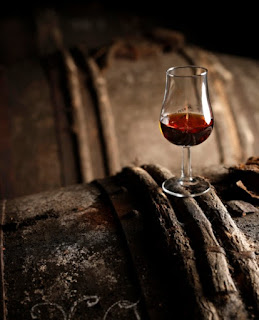Another single cask brandy with a serious age statement from Melbourne-based duo Old Master Spirits! These guys really are spoiling us...
Old spirits are often taken for granted, so let's get some perspective here. 1968. Well over five decades ago. The Vietnam war is at its peak, Martin Luther King has been assassinated, we're still a year away from landing on the moon, and I'm still sixteen years away from being born. Meanwhile in south-western France, this cognac was being distilled and filled into a cask, where it would stay for the next 55-years. Longer than many readers or their parents, or even grandparents, will have been alive. Absolutely crazy to think about. Even more so when you see the price - $299 AUD in a 500ml bottle. Yes, a 55-year old single cask cognac, naturally presented and cask strength, at a similar price to many Australian whiskies, many of which are also 500ml bottles and are only 2-3 years of age. That's just as crazy to think about as the 55-year age statement. Sure, you could point to our ridiculous tax system as the culprit, but all brandies still attract an excise of $93.44 AUD per litre of alcohol - $7 lower than other spirits, because the Australian government loves the wine industry and hates everyone else. Don't get me wrong, many of those Australian whiskies are delicious, and I don't intend to entirely turn to the dark side anytime soon. But this 55-year old cognac is a totally different proposition to whisky in terms of value for money, and spirits geeks always love an underdog. Frankly, this cognac too cheap - in fact it's $65 cheaper than this 51-year old cognac that Old Master released 18-months ago. I don't see how they're still doing this when the rest of the spirits world has gone mad with price increases! That's what happens when two drinks geeks take on a passion project and decide to show us what we've been missing.
This Old Master Spirits single cask cognac was distilled at Cognac Peyrot Francois, a small privately-owned producer five hours south-west of Paris in the heart of Cognac's Grande Champagne Cru appellation, the "crème de le crème" of the six cognac production regions. This single 25ha vineyard, known as "Les Bergeronnettes" (The Wagtails), was founded in 1893 and is currently in its fourth generation of family ownership. This 1968-vintage cognac was distilled by Mathilde Peyrot-Barret, grandmother of the current owners and daughter of vineyard founder Jean-Baptiste Peyrot. The vineyard began producing its own cognac in 1956, with the current alembic brandy stills being installed in 1967 - yes, the same stills that produced this 55-year old cognac are still in use today! This 1968 vintage cognac was distilled from Ugni Blanc grapes grown on vines dating back to 1928, and then spent its entire 55-years in Peyrot's cellar maturing in a single French oak cask before being bottled at a natural cask strength of 44.3% ABV. The cask was sourced from the famous Limousin Forest in central France, and yielded just 141 x 500ml bottles after its 55-years in oak - so just over 70-litres of cognac, i.e. not a lot, but that's to be expected after more than half a century in cask. Unlike most of the name brand cognacs and brandies, this independent bottling from Old Master Spirits ticks all the boxes that spirit geeks want - cask strength, natural colour, non-chill filtered, and no additives - no 'boise' wood flavouring, no sugar, no e150, no shenanigans. Single vineyard, unblended, and straight from the cask to the bottle, au natural. This 55-year old cognac is being released on Thursday the 26th of October 2023 - sign up to the Old Master mailing list here, or see here for more info. Happy hunting!
Old Master Spirits 55-year old Peyrot Cognac, 44.3%. Cognac, France.
Distilled 1968, fully matured in single Limousin oak cask, bottled at cask strength. Non-chill filtered, natural colour, no additives.
Colour: Rich mahogany.
Nose: Rich, sweet & fruity. Stewed stone fruit - apricot, plum, touch of yellow peach. Juicy sultanas, old leather armchair, dark chocolate mousse. Warm baking spices, touch of bitter orange peel, roasted chestnuts.
Texture: Medium weight. Rich, sweet, and juicy. No heat whatsoever.
Taste: Sweet stone fruit, both dried & stewed here. Apricot & plum again, with more raisins, and dark chocolate mousse. Sweetened espresso, rum & raisin fudge, and a touch of acetone-like floral sweetness.
Finish: Long length. Dark chocolate, baking spices, orange peel. Sweet raisins in syrup and oily furniture polish take over, with a little vanilla essence. Warm nutty oak, plum pudding, and woody cologne.
Score: 4.5 out of 5.
Notes: Extremely moreish, and absolutely delicious. Great balance of fruit, sweetness, and oak. This would have to be my favourite cognac to date, and also my favourite brandy to date. I can see why the Old Master Spirits team had to jump on this one as soon as they'd tried it. What a find, and what a buy! I've said it before and I'll say it again; any 55-year old single cask spirit for $299 AUD is an absolute steal, and deserves to be more widely appreciated. An equivalent whisky would easily be 20-times that amount, if not more. The same goes for the big cognac brands - which are all blended, and bottled at 40% ABV, and most are artificially coloured and have added flavouring. Natural cognacs like this one need no such rubbish. They're still hidden gems, but they can't stay that way forever. The more they increase in popularity, the more the pricing will start to creep. Am I helping by writing about it, then? Probably not... Don't miss this one if you're a brandy fan. And if you're unsure, split a bottle with a few friends to share the cost. You won't regret it!
Thanks to Deni from Old Master Spirits for the sample for this review. Once again my horizons have been broadened!
Cheers!






